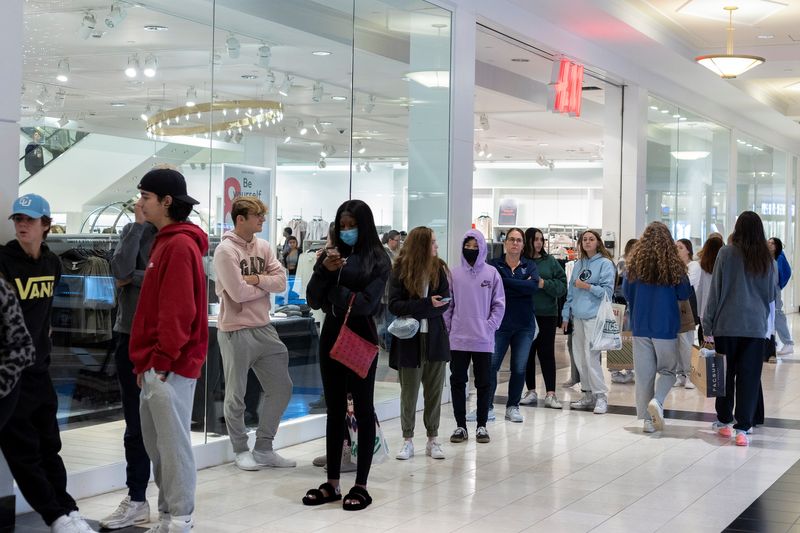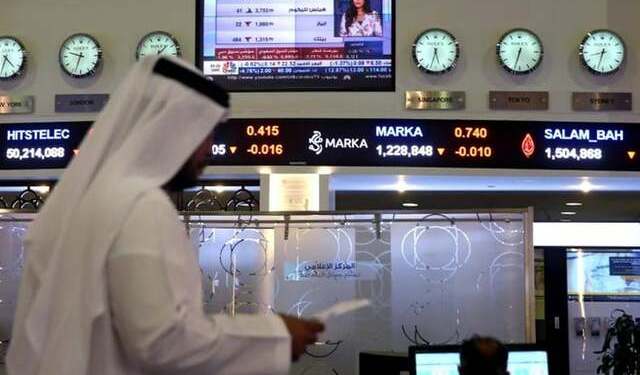
© Reuters. Shoppers line up for the Black Friday sales at the King of Prussia shopping mall in King of Prussia, Pennsylvania, U.S. November 26, 2021. REUTERS/Rachel Wisniewski
By Lucia Mutikani
WASHINGTON (Reuters) -U.S. consumer spending fell for a second straight month in December, putting the economy on a lower growth path heading into 2023, while inflation continued to subside, which could give the Federal Reserve room to further slow the pace of its interest rate hikes next week.
The report from the Commerce Department on Friday also showed the smallest gain in personal income in eight months in December, in part reflecting moderate wage growth, which does not bode well for consumer spending in the months ahead.
“The Fed needs to tread cautiously here with the economic outlook starting to darken,” said Christopher Rupkey, chief economist at FWDBONDS in New York. “Policymakers are closer to the end than the beginning in their inflation fight.”
Consumer spending, which accounts for more than two-thirds of U.S. economic activity, dropped 0.2% last month. Data for November was revised lower to show spending slipping 0.1% instead of gaining 0.1% as previously reported. Economists polled by Reuters had forecast consumer spending dipping 0.1%.
The data was included in the advance fourth-quarter gross domestic product report published on Thursday, which showed consumer spending maintaining a solid pace of growth and helping the economy to expand at a 2.9% annualized rate.
The weak handover to 2023 raises the risks of a recession by the second half of the year, but also reduces the need for the U.S. central bank to maintain an overly aggressive monetary policy stance. The Fed’s fastest rate hiking cycle since the 1980s has pushed the housing market into recession and manufacturing is in the early stages of a downturn.
Higher borrowing costs have undercut demand for goods, which are typically bought on credit. In December, there was a broad decline in goods spending, partly reflecting lower gasoline prices, which undercut receipts at service stations.
Spending on long-lasting manufactured goods like motor vehicles, recreational goods and household furniture and equipment decreased 1.9%. Durable goods spending plunged 3.0% in November.
Though growth in spending on services is helping to anchor consumption, some households, especially those with lower incomes, have depleted savings accumulated during the COVID-19 pandemic, limiting the scope of gains.
Spending on services increased 0.5% last month, matching November’s gain. Services outlays were supported by housing and utilities, air travel, and healthcare, as well as recreation.
U.S. stocks opened lower. The dollar rose against a basket of currencies. U.S. Treasury prices fell.
WAGE GAINS MODERATE
The personal consumption expenditures (PCE) price index edged up 0.1% last month after rising by the same margin in November. In the 12 months through December, the PCE price index increased 5.0%. That was the smallest year-on-year gain since September 2021 and followed a 5.5% advance in November.
Excluding the volatile food and energy components, the PCE price index gained 0.3% after climbing 0.2% in November. The so-called core PCE price index rose 4.4% on a year-on-year basis in December, the smallest gain since October 2021, after increasing 4.7% in November.
The Fed tracks the PCE price indexes for monetary policy. Other inflation measures have also slowed down significantly.
The Fed last year raised its policy rate by 425 basis points from near zero to a 4.25%-4.50% range, the highest since late 2007. Financial markets have priced in a 25-basis-point rate increase at the central bank’s Jan. 31-Feb. 1 meeting, according to CME’s FedWatch Tool.
Adjusting for inflation, consumer spending fell 0.3% in December, the biggest decline in a year, after decreasing 0.2%. This puts consumer spending on a lower growth base at the start of the first quarter. The outlook for spending is hazy, with personal income rising 0.2%. That was the smallest gain since April and followed a 0.3% increase in November.
Wages rose 0.3%, matching November’s increase. But with inflation retreating, consumers’ purchasing power is rising. Income at the disposal of households after accounting for inflation increased 0.2%. The savings rate rose to a seven-month high of 3.4% from 2.9% in November.
Source: Investing.com




























